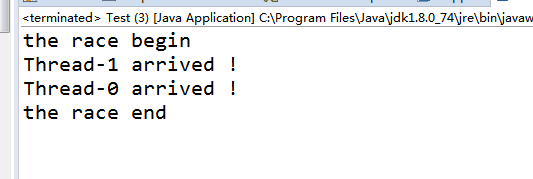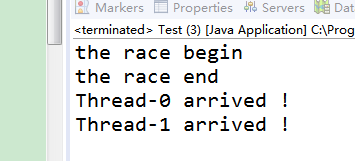CountDownLatch 使用说明
CountDownLatch是一种java.util.concurrent包下一个同步工具类,它允许一个或多个线程等待直到在其他线程中一组操作执行完成。
CountDownLatch的用法非常简单,下面的例子也是我在网上看到的,十分贴切,这里就贴出来
public class Test { public static void main(String[] args) { CountDownLatch begin = new CountDownLatch(1); CountDownLatch end = new CountDownLatch(2); for(int i=0; i<2; i++){ Thread thread = new Thread(new Player(begin,end)); thread.start(); } try{ System.out.println("the race begin"); begin.countDown(); end.await(); System.out.println("the race end"); }catch(Exception e){ e.printStackTrace(); } } } /** * 选手 */ class Player implements Runnable{ private CountDownLatch begin; private CountDownLatch end; Player(CountDownLatch begin,CountDownLatch end){ this.begin = begin; this.end = end; } public void run() { try { begin.await(); System.out.println(Thread.currentThread().getName() + " arrived !");; end.countDown(); } catch (InterruptedException e) { e.printStackTrace(); } } }
下面是运行结果

可以看到 通过CountDownLatch 的使用 我们控制了线程的执行顺序。
在上面代码中,我们使用到await()方法 和 countDown() 方法 。我们验证一下它们各自的作用。
首先 验证await() 方法。将main方法中的 end.await() 注释掉,下面是注释掉后的运行结果

可以看到主线程没有等待代表选手的线程结束,直接宣布比赛结束了!刚开始就结束的比赛- -
这里可以看出,await() 方法具有阻塞作用
其次 我们来验证countDown方法,将代表选手线程中的 end.countDown() 进行注释,下面是运行结果

程序一直在运行,所有选手都已经到了终点,但是裁判就是不宣传比赛结束,他在等什么呢?
我们猜测countDown() 方法具有唤醒阻塞线程的作用。
那我们也许会问,既然有唤醒阻塞线程的作用,那么我们只调用一次countDown() 方法不就是可以唤醒被阻塞的主线程了吗?
我们试一下,取消上面coutDown()的注释,再次创建一个选手,代码如下
class Player2 implements Runnable{ private CountDownLatch begin; private CountDownLatch end; Player2(CountDownLatch begin,CountDownLatch end){ this.begin = begin; this.end = end; } public void run() { try { begin.await(); System.out.println(Thread.currentThread().getName() + " arrived !"); // end.countDown(); } catch (InterruptedException e) { e.printStackTrace(); } } }
main 方法也修改如下,创建了两个不同的选手
public static void main(String[] args) { CountDownLatch begin = new CountDownLatch(1); CountDownLatch end = new CountDownLatch(2); Thread thread = new Thread(new Player(begin, end)); thread.start(); Thread thread2 = new Thread(new Player2(begin, end)); thread2.start(); try { System.out.println("the race begin"); begin.countDown(); end.await(); System.out.println("the race end"); } catch (Exception e) { e.printStackTrace(); } }
运行一下,下面是结果

主程序一直阻塞,没有被唤醒,裁判上厕所上得有点久啊!
这样看来countDown() 并不是直接唤醒线程,有点像一个计数器,倒计时的那种。
查看API文档,果然,我们在构造函数中添加了参数2,就需要调用 2 次 countDown() 才能将 end.await() 阻塞的线程唤醒。
CountDownLatch end = new CountDownLatch(2);
总结一下,
1、CountDownLatch end = new CountDownLatch(N); //构造对象时候 需要传入参数N
2、end.await() 能够阻塞线程 直到调用N次end.countDown() 方法才释放线程
3、end.countDown() 可以在多个线程中调用 计算调用次数是所有线程调用次数的总和
下一篇博客 我将从源码层面说明 CountDownLatch 的工作原理。


